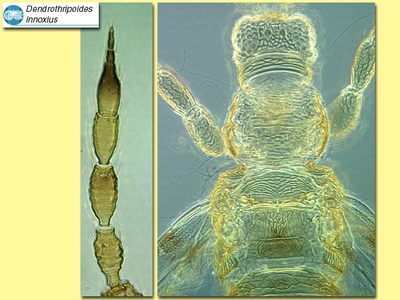Figures
Fig. 1 Antenna, head, pronotum, meso- and metanotum
Fig. 2 Fore and hind wing
Fig. 3 Head, thorax and abdomen, tergite III and IV
Species
Dendrothripoides innoxius Karny
Biology
This species feeds and breeds on the leaves of certain species of Ipomoea. In Australia it has been found commonly around Darwin on Water Spinach (I. aquatica).
Distribution
Widespread around the tropics, including northern Australia.
Recognition
Body colour usually golden yellow, lateral margins of pterothorax, metascutellum, and abdominal tergite I with brown markings; antennae yellow, VII & VIII brown also distal half of VI & IV; legs yellow; forewing pale with brown transverse band sub-basally and medially. Head with reticulate sculpture, cheeks angulate behind eyes, vertex narrowed into a transversely reticulate collar; ocellar setae small, arising on anterior margins of ocellar triangle. Antennae 8-segmented, III & IV with sense cone forked; VI with sense cone extending to apex of VIII. Pronotum with 1 pair of major posteroangular setae short but broadly flattened. Metanotum with median setae not at anterior margin. Forewings slender, major setae minute, hind margin and apex with long straight cilia. Legs with surface reticulate, tarsi 2-segmented. Abdominal tergites laterally with numerous long microtrichia arising from stout bases; tergites VI-VIII with one pair of median setae long, curved and pointing medially, IX & X with setae stout. Male similar to micropterous female, but tergite IX with pair of thorn-like setae medially arising from a stout tubercle, these setae overlying a triangular set of tubercles; sternites IV-VII with small glandular area anterior to antecostal ridge.
Related species
There are three other species in this genus, but all have restricted distributions in the Old World tropics.




